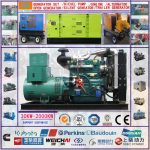Diesel Generators for Emissions Control A Comprehensive Guide

Introduction
Diesel generators have long been a reliable source of power for various applications, from backup power in critical facilities to primary power sources in remote locations. However, one of the major concerns associated with diesel generators is their emissions, particularly the release of harmful pollutants into the environment. In recent years, there has been a growing focus on emissions control for diesel generators to minimize their impact on air quality and public health. This article will provide a comprehensive guide to diesel generators for emissions control, covering the key pollutants emitted by diesel generators, regulations and standards governing emissions, and the technologies and strategies available for reducing emissions.
Key Pollutants Emitted by Diesel Generators
Diesel generators are known to emit several pollutants that can have adverse effects on human health and the environment. The primary pollutants emitted by diesel generators include:
1. Particulate Matter (PM): Particulate matter consists of tiny particles suspended in the air, including soot, dust, and other solid particles. PM emissions from diesel generators can contribute to respiratory problems, cardiovascular diseases, and other health issues.
2. Nitrogen Oxides (NOx): NOx is a group of gases that includes nitrogen dioxide and nitric oxide. NOx emissions from diesel generators can react with other compounds in the atmosphere to form ground-level ozone and smog, which can cause respiratory problems and contribute to the formation of acid rain.
3. Carbon Monoxide (CO): CO is a colorless, odorless gas that is produced when carbon-based fuels like diesel are burned incompletely. CO emissions from diesel generators can be harmful to human health, leading to symptoms like headaches, dizziness, and fatigue.
4. Hydrocarbons (HC): Hydrocarbons are organic compounds that are emitted during the combustion of diesel fuel. HC emissions from diesel generators can contribute to the formation of ground-level ozone and smog, as well as being a precursor to the formation of particulate matter.
Regulations and Standards Governing Emissions from Diesel Generators
To address the environmental and public health concerns associated with diesel generator emissions, various regulations and standards have been put in place to limit the amount of pollutants that can be emitted. Some of the key regulations and standards governing emissions from diesel generators include:
1. United States Environmental Protection Agency (EPA) Regulations: The EPA sets emissions standards for different types of engines, including diesel generators. The EPA's Tier standards set limits on emissions of NOx, PM, CO, and HC from diesel engines based on their size and application.
2. European Union Emissions Standards: The European Union has established a series of emissions standards known as the Euro standards for various types of vehicles and engines, including diesel generators. The Euro standards set limits on emissions of NOx, PM, CO, and HC from diesel engines to reduce their impact on air quality.
3. International Maritime Organization (IMO) Regulations: The IMO sets emissions standards for marine engines, including diesel generators used on ships. The IMO's MARPOL Annex VI regulations set limits on emissions of NOx, PM, and SOx from marine engines to reduce air pollution from ships.
4. State and Local Regulations: In addition to federal regulations, many states and local governments have their own emissions standards for diesel generators to address air quality concerns in their jurisdictions. These regulations may be more stringent than federal standards to protect public health.

Technologies and Strategies for Emissions Control in Diesel Generators
There are several technologies and strategies available for controlling emissions from diesel generators and reducing their environmental impact. Some of the key technologies and strategies for emissions control in diesel generators include:
1. 150kw diesel generator for remote research facilities : Exhaust gas aftertreatment systems are devices that are installed in the exhaust system of diesel generators to reduce emissions of pollutants like NOx, PM, CO, and HC. Common aftertreatment systems include diesel particulate filters (DPF), selective catalytic reduction (SCR) systems, and diesel oxidation catalysts (DOC).
2. Fuel Additives: Fuel additives can be used to reduce emissions from diesel generators by improving the combustion process and reducing the formation of pollutants. Additives like biodiesel, urea, and cerium oxide can help lower emissions of NOx, PM, and other pollutants.
3. Engine Optimization: Engine optimization involves tuning the diesel generator's engine to operate more efficiently and produce fewer emissions. Optimizing factors like air-fuel ratio, injection timing, and exhaust gas recirculation can help reduce emissions while maintaining performance.
4. Hybrid Systems: Hybrid systems combine diesel generators with other power sources like batteries or renewable energy sources to reduce fuel consumption and emissions. By using the diesel generator as a backup or supplementary power source, hybrid systems can lower overall emissions while providing reliable power.
5. Remote Monitoring and Control: Remote monitoring and control systems can help optimize the operation of diesel generators to minimize emissions. By monitoring factors like load demand, operating conditions, and emissions levels, operators can adjust the generator's settings to reduce emissions and improve efficiency.
Conclusion
Diesel generators play a crucial role in providing reliable power for various applications, but their emissions can have significant environmental and public health impacts. By implementing emissions control technologies and strategies, operators can reduce the amount of pollutants emitted by diesel generators and mitigate their impact on air quality. From exhaust gas aftertreatment systems to fuel additives and engine optimization, there are numerous options available for controlling emissions from diesel generators and promoting sustainable power generation. By adhering to regulations and standards governing emissions and adopting best practices for emissions control, operators can ensure that diesel generators remain a viable and responsible power source for the future.
